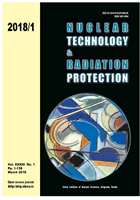
A NEW APPROACH ON MODELING OF THE B-VIII, THE ULTIMATE ACHIEVEMENT OF THE SECOND “URANVERAIN”
Pages: 1-33
Authors: Milan P. PešićAbstract
German Nazi state conducted researches in nuclear technologies as an attempt to achieve various military goals. As the result of these researches, German scientists developed different, advanced nuclear technologies in years before and during World War II. In an attempt to develop the “Uranmaschinen”, in which controlled release of high energy in fission process can be achieved, various approaches were examined, theoretically and experimentally. These studies were conducted under support of the German Nazi state and were known as the First and Second “Uranverain” (Uranium Society/Club). Versions of the “Uranmaschinen” were based, mainly, on natural uranium fuel and moderators of heavy water, regular water or paraffin. The latest known fission device was the subcritical nuclear fission reactor B-VIII, re-built in village Haigerloch, Bavaria, Southern Germany, in first months of 1945. It was a tank type device with natural uranium metal fuel and heavy water moderator, reflected by graphite. Radiation shielding of the device was achieved, primarily, by surrounding the reactor tank by regular water. The whole device construction was assembled inside a concrete hole in the floor of an underground cave, ex beer cellar. A recent neutronics study of this reactor was done, assuming fuel rods with lumped parameters approximation, by Italian Bologna University LIN (Laboratorio Ingegneria Nucleare) research group in 2009.
This paper is a new approach to the neutronics study of the B-VIII reactor with an attempt to model real fuel-moderator geometry. This study points out many approximations and simplifications, made during the B-VIII material composition and geometry modeling, due to missing data. The paper investigates the influence to criticality of numerous uncertainties in the material compositions, mass densities and geometry of the facility. The Monte Carlo MCNP6.1 code with the latest ACE type neutron nuclear cross section data is used for that purpose. Additionally, an attempt of estimation of the uncertainty of the experimental result of the neutron multiplication was given. Differences in the calculated values of the neutron multiplication and the experimental one are investigated and tried to explain. These analyses show that the B-VIII was a subcritical device, as it was shown by the experimental results of the German scientists achieved in March-April 1945 in Haigerloch.
Key words: Nazi nuclear program, B-VIII, neutron multiplication factor, MCNP6.1
FULL PAPER IN PDF FORMAT (3.22 MB)
